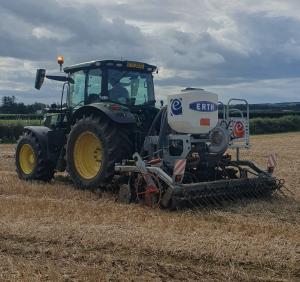The value of forage crops for finishing lambs
Date published:
By Jonathan Brown, CAFRE Beef and Sheep adviser

Now that winter cereal crops have begun to be harvested, it may be the ideal time for farmers to consider establishment of forage crops into stubbles. In this article the College of Agriculture, Food and Rural Enterprise (CAFRE) will provide guidance on utilising stubbles as part of a lamb finishing diet.
Grass availability and quality starts to decline as autumn approaches with some farmers considering the introduction of concentrate to lambs as a form of supplementation, however, this can cause production costs to rapidly increase. To mitigate this, having an option to include forage crops such as kale, forage rape and stubble turnips can reduce these costs and improve profitability.
Some varieties of stubble turnip can be grazed in around two months from sowing depending on conditions at establishment. For successful crop development and utilisation, there are some factors that need to be considered.
Sowing/Growing
Correct field selection is crucial. Choosing a field where the previous crop will be cleared in early August is beneficial, for example following a winter barley crop. This will allow for early drilling of the forage crop, and when establishment conditions are still suitable. As these forage crops are grazed, choosing land that is light, free draining, and with a pH close to 6.5 is beneficial. Ideal sites also provide natural shelter in terms of trees/ hedges for animals. Take care to avoid steeply sloping fields, or where watercourses are present.
Generally, the earlier crops are sown, the higher the yields. In most cases sowing forage crops into cereal stubbles does not require heavy cultivations. If soils are free from high levels of compaction, then direct drilling is advisable as it produces a firmer surface for grazing which reduces the risk of poaching, or alternatively light soil agitation by disc or tine prior to broadcasting may be suitable. Rolling after sowing is advisable for good soil to seed contact.
It is also important to consider nutrient levels of the soil, knowledge of inputs applied to the previous cereal crop and offtake levels will help guide decisions as to whether a light application of slurry or fertiliser is needed after sowing. An application of around 60kg nitrogen/ha can be beneficial to yield after a high yielding cereal has been grown. Apply phosphate and potash only if required based on accurate soil sampling. Monitor slug activity post sowing to ensure successful establishment.
Forage rape is often included in stubble turnip seed mixes. This provides extra crude protein for the lamb when grazing the crop
Feeding
Stubble turnips are very palatable to young lambs, so it is necessary to Introduce lambs slowly to the crop to avoid digestive upset. It has been recommended that forage crops should not exceed more than 60% of dry matter intake, so it’s advisable to have hay or straw available as a form of roughage to maintain healthy rumen function, preventing acidosis and bloat.
Placing bales in the field as the crop is sown prevents having to access the crop with machinery later in the year when ground conditions may have deteriorated.
Ideally a run back area should be available where the lambs can graze grass and lie down away from the forage crop area. Fresh water must always be available.
Strip grazing has a two-fold benefit, it prevents the animals from grazing just the leafy tops of the turnips and leaving behind the bulb, and it also reduces wastage thus maximising the utilisation of the crop. Avoid grazing ewes or older sheep on turnips as they may damage their teeth.
Feed Value
The energy levels supplied by brassicas is lower than concentrates or cereals, however, they are similar to quality conserved forages.
Stubble turnips alone have a digestibility value of 85, ME levels of 10-11, crude protein level of 17-18%.
Forage rape has a lower D-Value at around 80, however it does have higher protein content of 19-20%. This is why these two are often grown together.
These figures are based on strong crops that received adequate levels of nutrition and robust agronomy measures.
For further information, contact your CAFRE Adviser via your local DAERA Direct Office.
Notes to editors:
- Follow DAERA on X formerly called Twitter and Facebook.
- All media queries should be directed to the DAERA Press Office: pressoffice.group@daera-ni.gov.uk or telephone: 028 9016 3460.